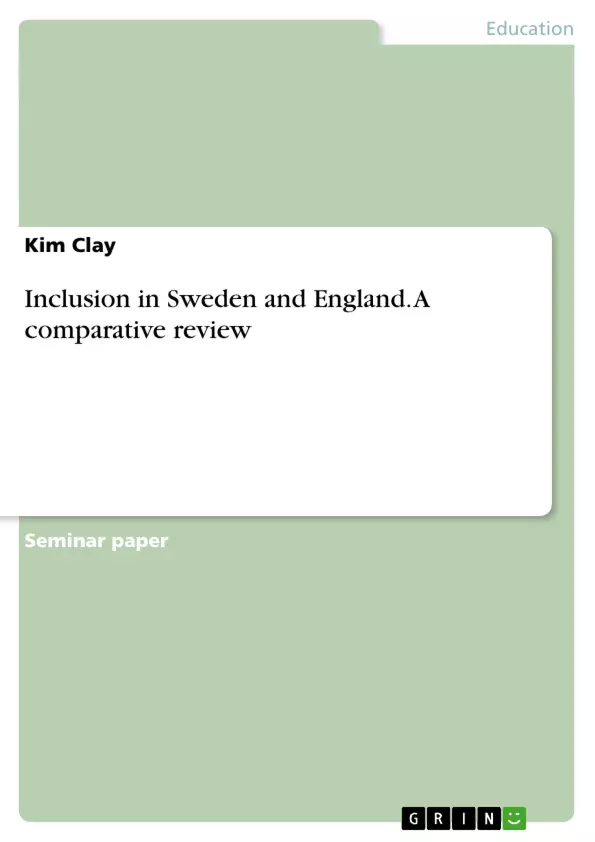This assignment is going to carry out a comparative review of inclusion policy and practice between England and Sweden. Comparative education has become very significant with countries trying to compete with others in an increasingly globalised world. According to Kelly et al (1982), comparative education draws upon multiple disciplines. It encourages critical questioning of education systems with no judgement or bias whilst fostering an awareness of economical and political factors. It is not just an academic exercise, but can in fact assist in the improvement of education.
Definitions and understandings of what is meant by inclusion differ considerably from country to country. In 1994, the Salamanca Statement was a significant document in the struggle to abolish segregated education which denies children with disabilities the right to be part of mainstream schooling. It was clearly defined in the Salamanca Statement and Framework plan for action on Special Needs Education that:
Schools should accommodate all children regardless of their physical, intellectual, social, emotional, linguistic or other conditions. This should include disabled and gifted children. In the context of this Framework, the term "special educational needs" refers to all those children and youth whose needs arise from disabilities or learning difficulties. Schools have to find ways of successfully educating all children.
Inhaltsverzeichnis (Table of Contents)
- Comparative review between inclusion in Sweden and England
- Definitions and understandings of what is meant by inclusion
- Categorizing types of SEN
- Sweden
- England
- Sweden's economic success
- Swedish education system reforms
Zielsetzung und Themenschwerpunkte (Objectives and Key Themes)
This assignment examines the policies and practices of inclusive education in England and Sweden, focusing on how these two countries approach and implement inclusive education. The assignment explores the various definitions and interpretations of inclusion in each country, along with the different models of inclusion employed. It also delves into the historical and socioeconomic contexts of both nations, highlighting how their specific circumstances influence their approaches to inclusive education.
- Comparative analysis of inclusion policies and practices in England and Sweden
- Different interpretations and definitions of inclusion across national contexts
- The role of historical and socioeconomic factors in shaping educational policies
- The impact of political and economic reforms on educational systems
- The influence of international frameworks and policies on national approaches to inclusion
Zusammenfassung der Kapitel (Chapter Summaries)
- The assignment begins by introducing the concept of inclusive education and its diverse interpretations across different nations. It highlights the Salamanca Statement as a landmark document in the fight against segregated education and emphasizes the importance of inclusive education for all children.
- The assignment then delves into the challenges of comparing inclusion policies and practices across countries, particularly due to variations in definitions and categories. It explores attempts by organizations like EADSNE and OECD to establish standardized frameworks for cross-national comparison.
- The assignment presents a detailed overview of Sweden's approach to inclusive education. It highlights the country's historical emphasis on a one-track approach, incorporating all pupils within mainstream education. It then discusses the shift towards a multi-track approach, which involves a range of services to ensure inclusion, including special needs provisions.
- The assignment examines England's complex approach to inclusion, noting the lack of a clear government policy and the diversity in interpretations. It explores the various perspectives on inclusion, ranging from focusing on children with special educational needs to promoting broader social inclusion.
- The assignment provides a contextual overview of Sweden's socioeconomic landscape, highlighting its strong welfare system, technological advancements, and economic successes. It emphasizes the role of universal free education in Sweden's post-war social policies.
Schlüsselwörter (Keywords)
The central keywords and focus topics in this assignment include inclusive education, special educational needs, comparative education, educational policy, national frameworks, international organizations, Sweden, England, Salamanca Statement, EADSNE, OECD, social inclusion, and economic reforms.
- Arbeit zitieren
- Kim Clay (Autor:in), 2010, Inclusion in Sweden and England. A comparative review, München, GRIN Verlag, https://www.grin.com/document/270195



